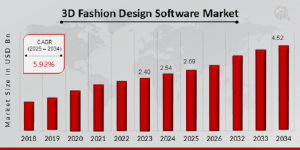3D Fashion Design Software Market Forecast to 2034: A Detailed Look at Growth Key Segments, and Regional Insights
3D fashion design software is advancing with AI, AR, VR, and SaaS, driving efficient, customized, and eco-friendly digital fashion.
The 3D Fashion Design Software Market is undergoing a transformative evolution as fashion brands and designers increasingly adopt digital solutions to enhance creativity, productivity, and sustainability. As the fashion industry continues to digitize, the demand for advanced design software has seen exponential growth. In 2024, the global market size for 3D fashion design software is projected to reach a significant valuation, and it is expected to witness a robust compound annual growth rate (CAGR) through 2034. These platforms enable designers to create realistic 3D garments, simulate fabric behavior, streamline prototyping, and reduce dependency on physical samples, thereby saving both time and cost. The software also supports digital fashion collections, virtual fitting, and e-commerce integration, aligning with the growing trend of virtual showrooms and sustainable practices. As fashion brands strive for faster time-to-market and cost-effective innovation, the role of 3D design tools is becoming indispensable across various segments of the apparel industry.
Download Sample Pages: https://www.marketresearchfuture.com/sample_request/24583
Market Segmentation:
The 3D Fashion Design Software Market is segmented based on component, deployment type, application, end-user, and region. By component, the market is classified into software and services, with software commanding a larger share due to its core functionality in design and development. In terms of deployment, cloud-based solutions are gaining traction owing to their scalability, affordability, and remote accessibility, although on-premises deployment remains relevant for enterprises requiring higher data security. Application-wise, the software is used for 3D garment visualization, textile simulation, virtual sampling, and fit testing. Among the end-users, fashion designers, apparel manufacturers, educational institutions, and e-commerce platforms form the primary user base. Educational institutions are leveraging the software for training aspiring designers, while e-commerce brands use it for developing virtual try-on features to improve customer experience. Regionally, the market is witnessing significant activity across North America, Europe, Asia Pacific, and other emerging regions, each driven by different factors such as technological adoption, manufacturing capabilities, and digital transformation initiatives in the fashion sector.
Market Key Players:
Key players dominating the 3D Fashion Design Software Market include:
• Virtual Mannequin
• Modaris
• TC2
• Human Solutions
• Marvelous Designer
• CLO Virtual Fashion
• Adobe Inc.
• Optitex
• Assyst
• Tukatech
• Browzwear
• 3DLyzer
• Lectra SA
• CDesign
• Gerber Technology Inc.
Browse In-depth Market Research Reports On 3D Fashion Design Software Market: https://www.marketresearchfuture.com/reports/3d-fashion-design-software-market-24583
Market Opportunities:
The market presents numerous growth opportunities fueled by increasing investments in digital transformation, the rising popularity of virtual fashion, and the urgent need for sustainable production practices. As brands seek to reduce fabric waste and lower their carbon footprints, 3D fashion design software provides a compelling solution by minimizing physical sampling and streamlining the design-to-production cycle. Another major opportunity lies in the integration of artificial intelligence and machine learning, which can help automate design suggestions, trend forecasting, and customer personalization. The metaverse and virtual reality spaces also offer emerging avenues, as fashion brands explore digital clothing for avatars and immersive online shopping experiences. Furthermore, the proliferation of online learning platforms and design education programs is expected to expand the software’s user base, especially among students and independent designers in developing regions who are gaining access to cloud-based and subscription-based software models.
Restraints and Challenges:
Despite the promising outlook, the market is not without its challenges. One of the key restraints is the high initial cost associated with implementing advanced 3D design software, which can be a deterrent for small-scale fashion businesses and individual designers. Additionally, the steep learning curve associated with mastering 3D tools can hinder widespread adoption, particularly among professionals accustomed to traditional design methods. Compatibility issues with other design and manufacturing systems may also pose technical barriers. Moreover, while cloud-based solutions offer flexibility, concerns regarding data security and intellectual property protection persist, especially when dealing with proprietary fashion designs. Limited internet access and infrastructure in some developing regions further restrict the software’s penetration, and there is an ongoing need for user training, technical support, and standardization to enable seamless workflow integration.
Procure Complete Research Report Now: https://www.marketresearchfuture.com/checkout?currency=one_user-USD&report_id=24583
Regional Analysis:
Regionally, North America currently leads the 3D Fashion Design Software Market due to its strong presence of technology providers, advanced fashion brands, and high digital adoption rates. The United States, in particular, remains a hub for innovation and early adoption, with fashion technology startups and major labels heavily investing in virtual design tools. Europe follows closely, supported by fashion-forward countries like France, Italy, and the United Kingdom, where sustainability initiatives and digital transformation in the fashion sector are prioritized. The Asia Pacific region is expected to exhibit the fastest growth over the forecast period, driven by the expanding textile and apparel manufacturing industries in China, India, Bangladesh, and Vietnam, along with growing investments in design technology and education. Latin America, the Middle East, and Africa are emerging markets with untapped potential, where increasing awareness, rising internet penetration, and digital education initiatives could pave the way for future adoption of 3D fashion solutions.
Recent Developments:
Recent developments in the 3D Fashion Design Software Market have been marked by significant technological advancements, strategic collaborations, and new product launches. CLO Virtual Fashion recently unveiled new simulation features and improved interoperability with other 3D platforms, enhancing designer workflows. Browzwear introduced AI-enhanced pattern adjustment tools and expanded its ecosystem through integration with popular PLM systems. Adobe’s Substance 3D suite has been gaining traction for its cross-industry capabilities, including fashion applications. Optitex and Gerber Technology have made strides in integrating 3D design with automated manufacturing workflows, making end-to-end digital garment production a reality. Furthermore, startups in the fashion tech space are increasingly focusing on sustainability metrics, virtual sampling, and social media integration, offering lightweight and user-friendly alternatives to traditional software. These developments signal a dynamic and competitive market landscape where innovation and user experience are at the core of growth strategies.
Related Reports
Supply Chain Big Data Analytics Market:
https://www.marketresearchfuture.com/reports/supply-chain-big-data-analytics-market-43776
Artificial General Intelligence Market:
https://www.marketresearchfuture.com/reports/artificial-general-intelligence-market-43786
Industrial Control For Process Automation Market:
https://www.marketresearchfuture.com/reports/industrial-control-systems-security-market-43797
Application Tracking System Market:
https://www.marketresearchfuture.com/reports/application-tracking-system-market-43806
Inertial Systems Energy Infrastructure Market:
https://www.marketresearchfuture.com/reports/inertial-systems-energy-infrastructure-market-43817
About Market Research Future:
At Market Research Future (MRFR), we enable our customers to unravel the complexity of various industries through our Cooked Research Report (CRR), Half-Cooked Research Reports (HCRR), Raw Research Reports (3R), Continuous-Feed Research (CFR), and Market Research & Consulting Services.
MRFR team have supreme objective to provide the optimum quality market research and intelligence services to our clients. Our market research studies by products, services, technologies, applications, end users, and market players for global, regional, and country level market segments, enable our clients to see more, know more, and do more, which help to answer all their most important questions.
Contact:
Market Research Future (Part of Wantstats Research and Media Private Limited)
99 Hudson Street, 5Th Floor
New York, NY 10013
United States of America
+1 628 258 0071 (US)
+44 2035 002 764 (UK)
Email: sales@marketresearchfuture.com
Website: https://www.marketresearchfuture.com
Sagar kadam
WantStats Research and Media Pvt. Ltd.
+91 95953 92885
email us here
Legal Disclaimer:
EIN Presswire provides this news content "as is" without warranty of any kind. We do not accept any responsibility or liability for the accuracy, content, images, videos, licenses, completeness, legality, or reliability of the information contained in this article. If you have any complaints or copyright issues related to this article, kindly contact the author above.
BOI Launches THECA 2025 to Position Thailand as Asia’s Most Comprehensive Electronics Ecosystem
Arab America Foundation Announces Speakers for CONNECT Empowerment Summit in New York/New Jersey, October 24-25, 2025
Hospital-acquired Bedsore and Death Claim Filed Against Alabama Hospitals
Więcej ważnych informacji
 Jedynka Newserii
Jedynka Newserii

 Jedynka Newserii
Jedynka Newserii

Prawo

Kolejne polskie miasta chcą być przyjazne dzieciom. Planują stworzyć najmłodszym dobre warunki do rozwoju
Cztery miasta w Polsce posiadają tytuł Miasta Przyjaznego Dzieciom nadany przez UNICEF Polska. Dziewięć kolejnych miast czeka na certyfikację, a w ostatnich miesiącach do programu zgłosiło się kilka następnych. Na całym świecie inicjatywa została przyjęta już w ponad 4 tys. samorządów, a w Hiszpanii objęła połowę dziecięcej populacji miast. Program UNICEF-u ma na celu zachęcenie włodarzy do traktowania najmłodszych obywateli w sposób podmiotowy, respektowania ich praw i zaproszenia ich do współdecydowania o przyszłości.
Przemysł
W ciągu roku w Polsce ubyło 500 przedsiębiorstw odzieżowo-tekstylnych. Problemem są spadki zamówień z Europy Zachodniej i wzrost kosztów

Wartość rynku odzieżowego w Polsce wynosi 66,9 mld zł, z czego 10 mld zł to wartość krajowej produkcji – wynika z danych PIOT. Od czasu pandemii branża mierzy się z szeregiem wyzwań, wśród których najpoważniejsze to wzrost kosztów pracy i produkcji, przerwane łańcuchy dostaw i spadek zamówień – zarówno w kraju, jak i za granicą, a także wzrost nieuczciwej konkurencji na rynku, czyli głównie importu z Chin. Skala wyzwań sprawia, że w ubiegłym roku z rynku zniknęło 500 firm. Producenci odzieży apelują do rządu o wsparcie.
Handel
D. Obajtek: Orlen powinien być o 30–40 proc. większą spółką. Byłoby to z korzyścią dla konsumentów

Orlen jest największym polskim przedsiębiorstwem. Jego przychody ze sprzedaży w 2024 roku wyniosły blisko 295 mln zł, a rok wcześniej – ponad 372 mln – wynika z raportu Rzeczpospolitej „Lista 500”. W ubiegłorocznym rankingu Fortune 500 uwzględniającym największe korporacje znalazł się na 216. miejscu na świecie i 44. w Europie. Według Daniela Obajtka, europosła PiS-u i byłego prezesa Orlenu, spółka powinna jeszcze urosnąć, tym samym gwarantując konsumentom szereg korzyści, a także przyspieszać inwestycje m.in. w obszarze petrochemii i energetyki zero- oraz niskoemisyjnej.
Partner serwisu
Szkolenia

Akademia Newserii
Akademia Newserii to projekt, w ramach którego najlepsi polscy dziennikarze biznesowi, giełdowi oraz lifestylowi, a także szkoleniowcy z wieloletnim doświadczeniem dzielą się swoją wiedzą nt. pracy z mediami.









.gif)

 |
| |
| |
|